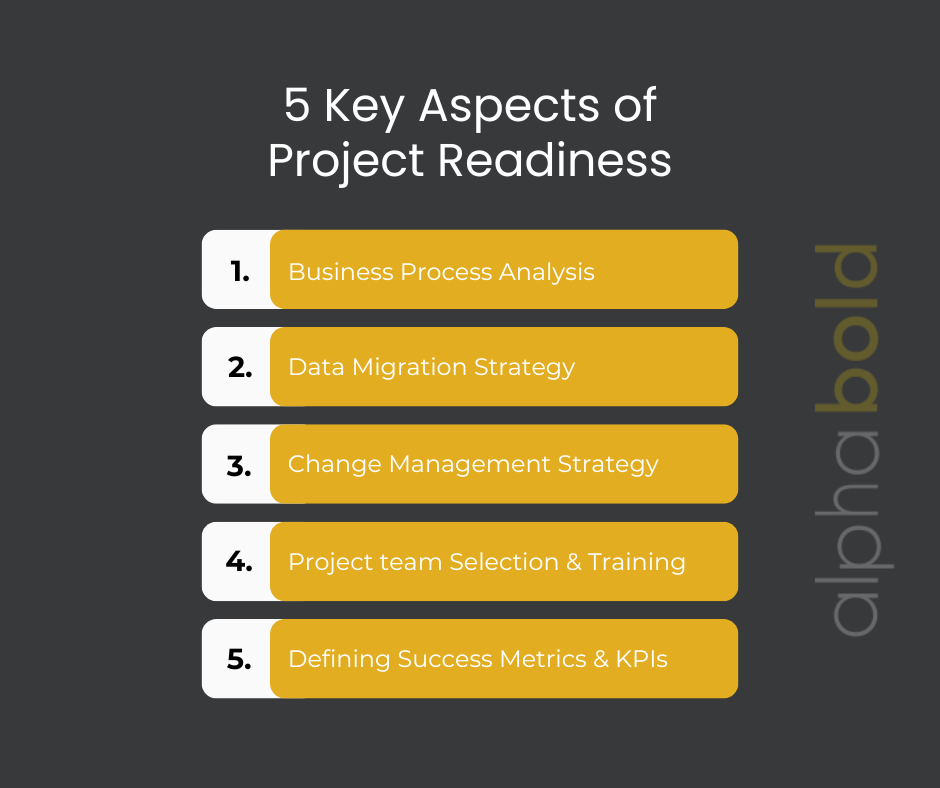Why Project Readiness Is Key to Implementation Success

Caroline Mayou
Introduction
This blog post dives into the key aspects of Project Readiness, outlining the steps you can take to ensure your software implementation is built to last. Imagine this: you’ve chosen the perfect new software solution, packed with features to streamline your operations. You’re excited to unlock its potential and watch your business soar. But hold on – before you hit “go” on implementation, there’s a crucial step often overlooked: Project Readiness.
Just like building a house requires a solid foundation, a successful software implementation hinges on a well-prepared team. Skipping this preparatory stage can lead to costly delays, frustrated users, and ultimately, a project that falls short of expectations.
Why Project Readiness Matters
Skipping project readiness might seem like a way to jump-start your software implementation, but it can lead to a host of hidden costs down the road. Let’s explore some of the biggest risks you’ll face.
Hidden Costs of Skipping Readiness
Imagine launching into implementation without a thorough understanding of your current processes and data landscape. Unexpected challenges are almost guaranteed to arise during this phase. These roadblocks can quickly lead to delays in your project timeline, pushing your initial budget well past its allocation. Additionally, the need for quick fixes and adjustments on the fly can cause your project scope to balloon, further increasing costs and extending the implementation timeframe.
The impact on user adoption can be equally detrimental. Without proper communication and training, users may resist transitioning to the new software. This can lead to frustration and low adoption rates, ultimately rendering the project a failure. A robust change management strategy, developed during the project readiness phase, is essential for ensuring user buy-in and smooth adoption.
In short, neglecting project readiness can turn a seemingly cost-saving measure into a financial burden. The ripple effects can ultimately jeopardize the entire project’s success. By investing in a thorough readiness phase, you can avoid these pitfalls and set your software implementation up for long-term success.
Building a Strong Foundation for Implementation
By contrast, investing in a thorough readiness phase lays a strong foundation for your software implementation. This includes establishing clear communication channels to ensure everyone involved receives timely and accurate information. It also fosters collaboration among stakeholders, allowing different teams to work together seamlessly towards shared goals. Project readiness activities also promote stakeholder alignment, guaranteeing everyone is on the same page regarding project objectives and expectations.
A well-prepared team will have a clear understanding of potential challenges. By proactively identifying these roadblocks during the readiness phase, the team can develop contingency plans to mitigate risks. This proactive approach leads to a smoother implementation process, reduced costs, and ultimately, a higher chance of achieving your desired outcomes.
Implementing New Software?
Feeling unsure how prepared your team is for a software implementation? Get a free project readiness assessment from AlphaBOLD Consulting. We'll identify areas for improvement and ensure your transition is smooth.
Request consultationKey Aspects of Project Readiness
A successful project readiness phase involves several key activities that prepare your team for a smooth software implementation. Here are some of the most important aspects to consider:
1. Business Process Analysis
Before diving headfirst into the functionalities of your new software, it’s crucial to take a step back and examine your current operations. This process, known as business process analysis, is the foundation for a successful software implementation.
- Identifying inefficiencies in current processes: Before diving into the new software, take a deep dive into your existing workflows. This analysis will help you identify areas for improvement and streamline your operations. By uncovering inefficiencies, you can avoid simply automating a broken process.
- Aligning new software with optimized workflows: Once you understand your current processes, you can map them to the functionalities offered by the new software. This ensures the software is configured to support your optimized workflows, maximizing its effectiveness within your organization.
2. Data Migration Strategy
- Planning for data cleansing, transformation, and migration: A critical component of any software implementation is data migration. This process involves transferring your existing data to the new system. However, data quality is crucial. A project readiness phase allows for planning data cleansing activities to remove inaccuracies and inconsistencies. You can also develop a data transformation strategy to ensure your data is formatted appropriately for the new system.
- Ensuring data integrity and system functionality: By prioritizing data quality during the readiness phase, you can ensure the integrity of your data in the new system. This reduces the risk of errors and system malfunctions, leading to a more functional and reliable software implementation.
3. Change Management Strategy
With your business processes optimized and data migration strategy in place, it’s time to focus on the people impacted by the new software: your users. Change can be disruptive, and successful software implementation hinges on user adoption. This is where a robust Change Management Strategy comes into play. Developed during project readiness, this strategy will guide your communication efforts and ensure a smooth user transition to the new system. Let’s delve into the key components of a successful change management strategy.
- Proactive communication plan to address user concerns: Change can be disruptive. A well-developed communication plan, established during project readiness, is essential for keeping stakeholders informed and addressing user concerns throughout the implementation process. Transparency and open communication will help build trust and encourage user buy-in.
- Training and adoption initiatives for smooth transition: Providing comprehensive training to your users is crucial for ensuring a smooth transition to the new software. The project readiness phase allows for developing training programs that cater to different user skill levels and learning styles. Additionally, planning for adoption initiatives can help incentivize users to embrace the new software and maximize its benefits.

4. Project Team Selection and Training
Having addressed your business processes, data migration, and user adoption strategy, it’s time to assemble the team that will lead your software implementation to success. The right team, equipped with the necessary skills and knowledge, is essential for navigating the complexities of this process. Project Team Selection and Training, a crucial aspect of project readiness, ensures you have the right people in place with the right tools to get the job done. Let’s explore the key considerations for building a strong project team.
- Choosing the right team with the necessary skills and experience: Assembling the right project team is vital for success. During project readiness, you can identify team members with the technical expertise, project management skills, and change management experience required to lead a successful implementation.
- Providing training on the software, project management methodologies, and change management processes: Equipping your team with the necessary knowledge is key. The project readiness phase allows for providing training on the new software, relevant project management methodologies, and change management processes. A well-trained team is better prepared to navigate the complexities of software implementation and overcome challenges that may arise.
5. Defining Success Metrics and KPIs
So far, we’ve explored how project readiness activities lay the groundwork for a smooth software implementation. We’ve covered optimizing workflows, ensuring data quality, and preparing your users for the transition. But how will you know if your implementation is on track and achieving its desired outcomes? This is where Defining Success Metrics and KPIs comes in. By establishing clear goals and measurable benchmarks during project readiness, you can effectively track progress and make adjustments as needed throughout the implementation process. Let’s explore how defining success metrics can help you achieve a successful software implementation.
- Establishing clear goals and benchmarks to measure progress: Setting clear goals and establishing measurable benchmarks is essential for tracking project progress. During the readiness phase, you can define key performance indicators (KPIs) that align with your overall project objectives. These metrics will enable you to monitor performance and make adjustments as needed throughout the implementation process.
By focusing on these key aspects of project readiness, you can lay a solid foundation for a successful software implementation. In the next section, we’ll explore how AlphaBOLD Consulting can help your organization achieve project readiness and ensure a smooth transition to your new software solution.
Request An Assessment
Worried about hidden costs lurking in your software implementation? Let AlphaBOLD Consulting conduct a project assessment. We'll identify potential cost risks and provide a comprehensive overview of your implementation expenses. Contact us today to get a clear picture of your software implementation budget and ensure a successful journey!
Request ConsultationConclusion
Taking the time to invest in a thorough project readiness phase is not just recommended, it’s essential for a successful software implementation. Just like building a house requires a solid foundation, a well-prepared team is the cornerstone of a smooth and efficient implementation process. Skipping readiness can lead to costly delays, user frustration, and ultimately, a project that falls short of its goals.
By contrast, a robust project readiness phase offers a multitude of benefits. It fosters clear communication and collaboration among stakeholders, ensuring everyone is aligned on project objectives. It allows for identifying and mitigating potential risks, preventing costly surprises down the road. Most importantly, it prepares your users for the transition, increasing adoption rates and maximizing the value you get from your new software investment.
Explore Recent Blog Posts







